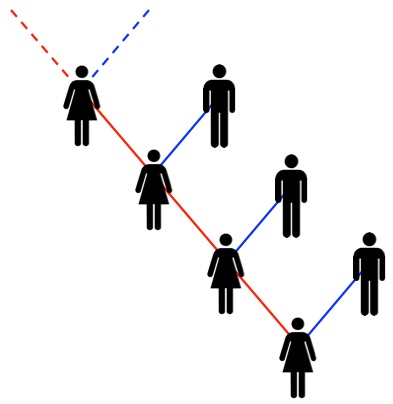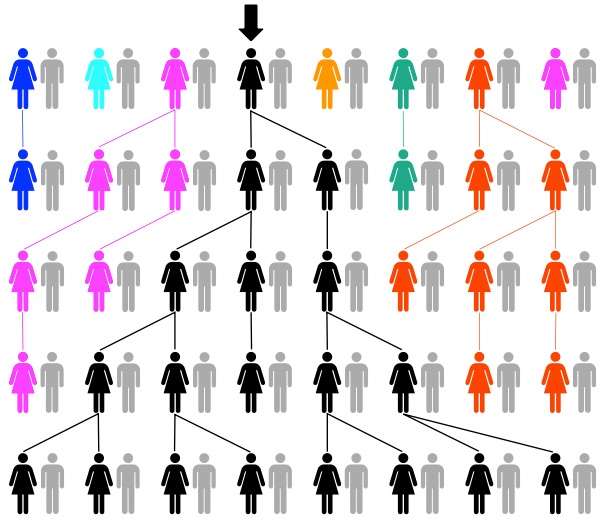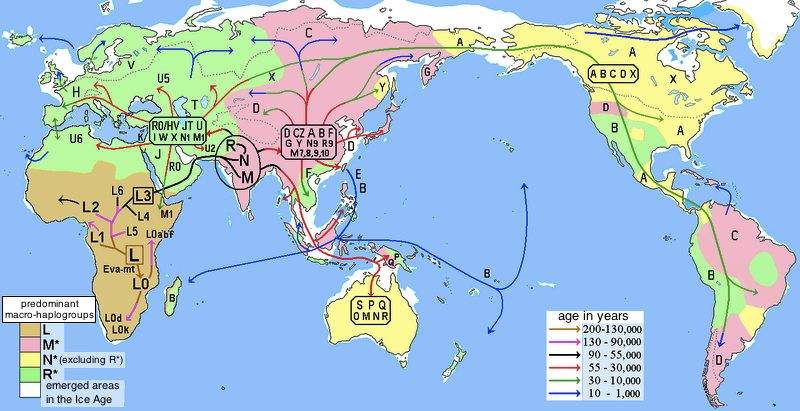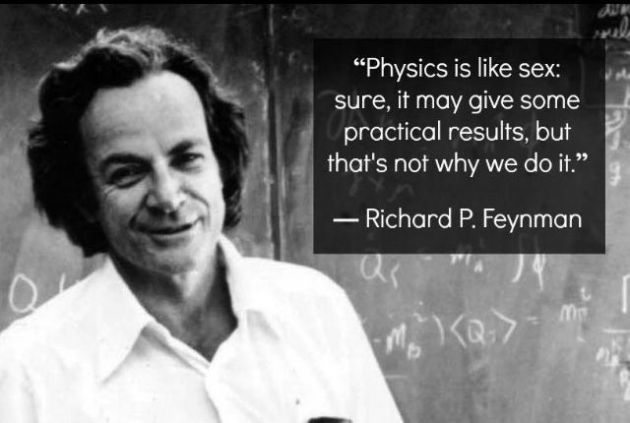The original question was: From biology and genetics we know that any group of living organisms had a mitochondrial most recent common ancestor (mitochondrial Eve): a female organism who lived in the past such that all organisms in this group are her descendants.
How can we [theoretically] prove this? (I.e. without assumption that there’s equal probability to mate for any two individuals).
Also: can we prove that one of 3 billion women currently living on Earth will be the only ancestor of all human population some day in the future, and all other currently living women (except her mother and daughters) will have no descendants at that day?
Physicist: The fact that everyone on Earth has a common female ancestor if you go back far enough is a direct consequence of the theory of common descent. It looks like everything that lives is part of the same very extended family tree with a last universal common ancestor at its base. In order to have two familial lines that never combine in the past you’d need to have more than one starting point for life, and all the evidence to date implies that there’s just the one. Luckily, you don’t have to go all the way back to slime molds to find common ancestors for all humans; the most recent were standard, off-the-shelf people.
It turns out that animal and plant cells aren’t particularly good at producing usable energy, so before we could get around to the business of existing we needed to get past that problem. The solution: fill our cells with a couple thousand symbiotic bacteria. Literally, they’re not human; mitochondria reproduce on their own and have their own genetic code. There’s a hell of a lot of communication and exchange of material between them and our cells, and without them there wouldn’t be an us, but they are (arguably) separate organisms that we are absolutely dependent on and which are completely dependent on us.
Here comes the important bit: eggs cells have mitochondria but sperm cells don’t, so mitochondria are passed strictly from mother to child. There’s no implicit reason for your mitochondria and your father’s to be related at all. The nice thing about that is that it keeps the genetic lineage very simple: all of your mitochondria are essentially clones of those in the egg cell you started as and (for our female readers) any of your children’s mitochondria will essentially be clones of yours. The genes of sexually reproducing beings are a lot trickier to keep track of over time; every generation half of our genes are dumped and the other half are shuffled with someone else’s (which makes your DNA is unique). The one real advantage to talking about mtDNA (mitochondrial DNA) is that you only have a single chain of ancestors to worry about. By the way: you can do exactly the same thing with the Y-chromosome and direct male lines.

Mitochondria are passed only from mother to child, so if you follow your direct female line back, you’re following your mitochondria’s ancestors as well.
If you have a group of creatures with two types of mitochondria, two “haplogroups“, living under a population ceiling, then eventually one or the other will be bred out. The math behind this is essentially the Drunkard’s Walk. The number of folk in a haplogroup can increase or decrease forever, unless it gets to zero; given nough time and no where else to go (a population limit), eventually the drunkard’s walk will take him off a cliff (zero population). So, if you start with a small village and several haplogroups, then after a few generations you’ll probably have fewer.

Why did that particular woman become the Mitochondrial Eve instead of one of the others? Luck and fecundity.
That isn’t saying much. It boils down to the rather fatalistic statement that “in order to be the last thing standing, you just have to wait for everything else to die off”. We can’t prove that a woman today will eventually be declared, very post-mortem, the Mitochondrial Eve to everyone (that is; all but one haplogroup will die off). But statistically: that’ll definitely happen. To within less than a 1% error, every inherited line of every kind has died off; practically every species, sub-species, gene, haplogroup, whatever, has gone extinct leaving only the amazing scraps that remain. That’s evolution in a nutshell: you chip away all the life that isn’t an efficient, functioning organism (and then a hell of a lot more besides) and the inconceivably tiny fraction that remains is (some of the) efficient, functioning organisms. So, chances are that every living haplogroup presently around will go extinct eventually. When there’s one haplogroup left, then you can say that they all have a common Mitochondrial Eve and when there are zero haplogroups left, then all human issues become moot.
In order to definitely not get a modern Mitochondrial Eve, you’d need human populations that are absolutely independent (and viable) forever. Maybe if we colonized Mars and then completely forgot it?
So, if any given haplogroup eventually dies out, then why is there more than one? Well good news: over long time scales (millennia) mtDNA accrues tiny changes through random mutation, leading to a relatively few distinguishable lineages. We live in a kind of meta-family tree, where each branch is entire groups of female lines. Even though some branches stop, others will randomly sprout new branches (“new” meaning “with mtDNA that’s detectably different at all”).

By reading the mtDNA of people from all over the world, you can track how folk have expanded across the planet.
In fact, by carefully looking at the differences in our mtDNA and theirs, we can show that Neanderthals are not a parent species of ours, but cousins, and the common “Eve” that we share with them lived around half a million years ago. We can do the same thing with regular genetics and damn near any living thing to see how and how closely we’re related.
Humanity’s (present) Mitochondrial Eve is not our unique common ancestor nor is she our most recent common ancestor. Mitochondrial Eve is merely the most recent ancestor of all living people by means of a direct female line alone. If you allow for the inclusion of both men and women, then our most recent common ancestor jumps from around 120,000 – 150,000 years ago, for direct female lines only, to as recent as 3,000 years ago, for any ol’ lines. There’s no way to even reasonably guess who or where any of these common ancestors were. Probably lived near big population centers? Maybe?
Looking at mitochondria is a solid, simple way of understanding evolution and inheritance, but it doesn’t paint an accurate picture of how genes move around populations. An important fact to keep in mind is that a huge fraction of the people alive today will eventually be a common ancestor to all of humanity. Even if your family doesn’t increase or decrease the population (every couple has two kids), your family is still going to grow exponentially (2 kids, 4 grandchildren, 8 great-grandchildren, …). It only takes about 30 generations to have a billion descendants (less if you really work at it), so if you have kids, and they have kids, and so on, then in less time than you’d expect (not forever anyway) your genes will be spread thinly throughout all of humanity. Many of your particular genetics won’t make it, but many of them will. For example, if your haplogroup dies out then your mtDNA won’t be around, but the genes that dictate, say, the shape of your earlobe might end up all over the place.

Too true.
Arguably, that’s the reason for sex. Maybe not the first reason most folk would cite, but they weren’t at the meeting a billion years ago. By mixing our genes every generation we can prevent genetic lines from disappearing forever, which is good: more diversity means more combinations for evolution to try out in a pinch. Almost as good, useful mutations and combinations of genes can be distributed and used by (a random subset of) the entire species after a mere few thousand years! Sexual reproduction literally makes us much better at evolving. Huzzah for doing it!







Another great article! Thanks for the insight, Physicist. Although aware that we all supposedly came from a single African female, I hadn’t really thought through the reason. I think I assumed that some female ancestor was probably merely a genetic aberration that survived when other sub specie varieties didn’t. Which is still sort of true.
But it makes so much sense to follow common descent. For every “act of love” there are two ways for a particular female to fail in passing-on her mitochondria-DNA and only one to succeed. It’s a law of diminishing returns I think. One way to fail is to not produce a successful birth at all. The other is to produce only a male birth(s). Success continues to reign only when another female off-spring is born that “might” again be lucky enough to get away with passing the mtDNA at least one more time against these unlucky odds.
So one might think that all female lines could die out and the species fail altogether. And that seems a true fact that may also occur, but that last female will surely come from the longest ancestral mtDNA line. One quirky example of success might be the fact that the final version of species that survived (us!) is sort of a mix of two other subspecies, Neanderthal and Cro-Magnon. In other words, modern humans are still considered Cro-Magnon, but they are not quite as pure a breed as they would be if the two subs had not interbred. So if a modified species survives at all, it should be because at least one line including a female Neanderthal was more prolific which increases the odds-of-beating-the-mtDNA-odds down the line. Of course it seems there are probably some good fertility genes, possibly Neanderthal, involved in winning (or outlasting) also. Off-hand, the name Homo Sapiens (us!) will do and the name Cro-Magnon is not heard much anymore for some reason.
Wes
https://en.wikipedia.org/wiki/Paternal_mtDNA_transmission
Maybe the fact that female lines get extinct fast enough is because new species emerge which do not let interspecies reproduction?